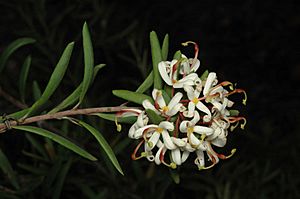Mountain guitar plant facts for kids
Quick facts for kids Mountain guitar plant |
|
|---|---|
 |
|
| Scientific classification | |
| Genus: |
Lomatia
|
| Species: |
polymorpha
|
The Lomatia polymorpha, also known as the mountain guitar plant, is a special type of shrub or small tree. It belongs to the Proteaceae plant family. This plant is endemic to Tasmania, which means it grows naturally only in Tasmania and nowhere else in the world! It's a common plant there, often found in areas different from its close relative, the L. tinctoria.
Contents
About the Mountain Guitar Plant
The mountain guitar plant is usually a shrub, but it can also grow into a small tree. It typically reaches a height of about 2.5 to 4 meters (8 to 13 feet). Its leaves are quite simple and can be shaped like a line or a narrow egg. They are usually 20 to 80 millimeters (0.8 to 3.1 inches) long and 2.5 to 10 millimeters (0.1 to 0.4 inches) wide. Each leaf has a small stalk about 5 millimeters (0.2 inches) long. Sometimes, the edges of the leaves have a few small bumps or teeth.
The stems of the plant can have a covering of tangled hairs. The underside of the leaves is covered with rusty-colored hairs and has a clear main vein running through it. The flowers are white, cream, or greenish-white. They appear between January and March. After the flowers, the plant produces fruits that are dark grey to black and about 20 to 30 millimeters (0.8 to 1.2 inches) long.
Where Does the Mountain Guitar Plant Live?
The mountain guitar plant is a very common and widespread species in Tasmania. You can find it mostly in the southern and western parts of the island. It grows in different places, from woodlands in high mountain areas to scrubby areas in wetter lowlands. Sometimes, it even grows in rainforests. You can find it from sea level all the way up to 1200 meters (about 3,900 feet) high.
In some areas, like near Lake St Clair, the mountain guitar plant grows in the same places as its relative, L. tinctoria. When this happens, the two plants can sometimes mix and create new plants called hybrids.
How Was the Mountain Guitar Plant Named?
The mountain guitar plant was first officially described and named in 1810. This was done by a famous botanist named Robert Brown. He published his description in a scientific journal called Transactions of the Linnean Society of London. This is how plants get their scientific names and become known to the scientific world.
Growing the Mountain Guitar Plant
This plant is quite tough and easy to grow in gardens. You can start new plants from seeds or by taking cuttings from an existing plant. It grows well in most types of soil and can handle different amounts of sunlight. This makes it a good choice for people who want to grow native Tasmanian plants.

